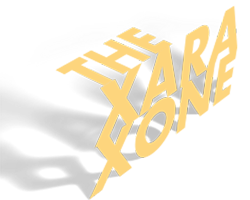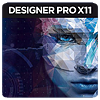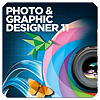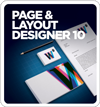
Download Resource File
Tips and Tricks Tutorial
By Gary David Bouton (“gare” Online)
Making a Varsity-Style Logo
The idea of pushing two (or sometimes more) glyphs together so they artistically embrace one another is not a new idea. My first impression of this typographic effect was on a letterman’s sweater in college. You’re going to walk through the technique for creating interlocking initials that will be used later as a logo for a men’s apparel line.
The first stop is a place online where you can get the base typeface for this assignment. Nate Piekos at Blambot.com created a free typeface called Mutant Academy BB, which is very, very similar to Princetown, a font that appeared in the early 1990s and distributed by ITC. To download Mutant Academy BB, go to http://www.blambot.com/font_mutantacademy.shtml, click the format of font you want (Hint: Truetype enables you to use the typeface with Xara 3D Maker), and then install it before continuing, as sort of shown in Figure 1.

Stretching Characters in a Novel Way
In earlier versions of Xara, all you had to do to disproportionately stretch a line of text was to drag a middle control handle with the Selector tool. Later versions, such as 9 and up, require you to either use the Text tool’s Infobar, or (more simply) group the single shape of text ( Ctrl+G) and then drag a middle control handle. However, this design calls for a third method where the text is converted to editable shapes, and control handles in the resulting shapes are nudged to created wide versions of the characters, but preserving the line width of the character (which is a really neat discovery!). Here’s how to prep your characters for the designer logo:
-
Go to Window>Control Bars on Xara Designer’s main menu. In the Control Bars box, put a check in the box for the Arrange menu. You can close this dialog box now. See Figure 2.

-
All the Arrange commands are now docked at the top of the screen; why not detach the commands and let them float in the UI? Be very careful to put your cursor on the strip and not any of the buttons themselves, and then drag the control bar into the workspace. Then put your cursor on the vertical (the narrow) edge of the control bar and drag toward its center to make a palette out of the control bar, as shown in Figure 3.

The reason why you should have the Arrange commands on a palette floating in the workspace is that this tutorial uses the Arrange>Combine Shapes> All those Boolean Commands. And leaving your work just to mouse up to the main menu, to then dig through two levels of commands is about as fun fixing a flat tire in the rain.
-
Ready, steady, go! In Xara, on a new page, choose the Text tool and then type
BL. -
Highlight the text, and then click in the Font drop-down list on the Infobar to put this area of the interface “in focus”.
-
Start typing
Mutantuntil the font name appears in the font box. You’ll soon reach the font you need. HitEnterto apply the Font change to your text. -
Now, you can either type about 171 points in the Font size box to the right of the Font drop-down, or scale the text to about 2” using the Selector tool. Figure 4.

It’s important in this example to make the text 2” high because other dimensions in this tutorial depend on this size to have proportional effects. In your own work, and once you’ve absorbed what this tutorial does, you should feel free to use any font size, and actually, almost any font you please.
-
With the text selected, use the Arrange control bar command button for Convert to Editable Shapes. Press
Ctrl+Utwice to ungroup the shapes completely. You’ll see the individual control points along the paths of the shapes and that’s what we came here for. -
Recolor each shape so you can see which one is which. Put the B over the L shape more or less centered, and then with the Shape tool, marquee selected the right side of the B’s control points as shown in Figure 5 (it’s important that you look at this figure!), and then use the nudge keyboard arrow keys to move portions of the B to the right.

-
Move portions of the B to the left by marquee selecting control points on the left, and nudging them left. Take your time; this is not an intuitive process, selecting only the control points that affect the vertical stem widths on the character. After a try or two (be prepared to press
Ctrl+Z), you’ll certainly understand the process and how to do it. In order to interlock the two characters, the B needs to be more than wide enough in its holes (the counter in a type character) to let the L run through them, with a little space added for a Contour you may choose to add later. And in turn, the L needs to be tall enough to clear the top and bottom of the B. -
Moving on to the L once the B’s holes are wide enough, marquee select the top control points of the L, and then nudge them upwards until they clear the B, with a little space to spare. Then marquee-select the bottom control points of the L and nudge them down until the areas clears the bottom of the B with some room to spare, as shown completed in figure 5. If your drawing looks like Figure 5, you’re ready to move on to the next section. Save this document and keep it open.
Some Mind-Boggling Boolean Ops
Hopefully, the reason for the commands to follow will make sense and you’ll be able to produce any sort of interlocking logo you like in the future. Let’s take this next section slowly, and methodically, okay?
-
With both shapes selected (you can apply a Contour to more than one shape at a time), choose the Contour tool, and then drag one of the control handles outward by five pixels, or type
5pxin the field on the Infobar. Make sure the Miter Joint type of control handle property is pressed in this example. Type1in the Steps box. -
With the Contour tool, click very precisely and carefully on the contour that surrounds the B shape, and then choose a contrasting color on the color line. Then do the same to the L shape, until your shapes look more or less (depending on the colors you choose) like those shown in Figure 6.

-
Press the Convert to Editable Shapes button on the Arrange control bar (the circle with four control points around it), and then press
Ctrl+Utwice to thoroughly ungroup the groups of shapes, four in count. -
Go get the drawing tool of your choice, and then create two shapes over the B in the composition; one over the top horizontal stem of the B, and one on the bottom of the horizontal stem. They should cover the height of the two stems and only need to be as wide as to go just outside of the contour shape of the L, as shown in Figure 7.

-
With the Selector tool, Shift-select both shapes and then click the Add Shapes button on the Arrange control bar.
-
With this one shape, Shift-click on the contour surrounding the B to add it to your current selection and then click the Subtract button on the Arrange control bar, again shown in Figure 7.
What you’ve done is set up conditions in this drawing that will result in the L shape apparently, artistically, “going over” the top and bottom stems of the B in the final drawing. To continue…
-
Select the B contour and the L shape and then click the Subtract shapes button on the Arrange control bar. See Figure 8; apparently nothing has happened, but if you were to move the top B, you’d see that the contour that was deleted as part of the Subtract operation took the horizontal center out of the L, which will eventually make the L look as though it’s going under the center stem of the B. Let’s take a break for a moment; press
Ctrl+S; keep the document open.
Finalizing the Shape of the Shapes in the Logo
There are really only three more steps you need to perform to getting this logo finished. However, you should take some time and reflect on the steps you’ve taken so far, because:
-
Which two characters you yourself will combine in this artistic fashion are unknown to you at this point. Do you want a character such as a P that has only one hole, or two as you’re performing with the B so a different character can weave in and out of the top character?
-
Do you want one character over the other, or vice-versa? In this example, the B over the L made logical sense, as did making the B very wide and the L very tall. In the spare time you don’t have, try doing the reverse and see how lousy the logo looks. Pay extra care to the choice and positioning of the 2 characters. Yep, you could hypothetically do a three character logo, but you’d have to have the patience of a Saint and the spare time of Chronus!
-
Read and re-read this tutorial to get a firm understanding of which parts of fonts need what type of Boolean operation, and why. The Add, Subtract, Intersect operations make quick and accurate work of trimming unwanted areas out of your logo, but can you tell which one produces what result? When you can, it’s time to take on the fourth bulleted point here!
-
Choose your typefaces carefully. Mutant Academy very easily lends itself to this intertwining logo because the stems were quite easily edited with the Shape tool. Begin your own logo editing adventures with a sans serif font such as Futura, move your way up to a slab serif font such as Lubalin Graph (or similar typeface), and eventually get into real editing challenges such as using Goudy, or other Roman typeface. For 100 additional points, try intertwining script characters once your skill level bores you taking on lesser challenges.
Okay, let’s get to the steps:
-
Click on the contour L shape and then press
Ctrl+Fto put the shape to the front of the stack of shapes. -
Create two somewhat rectangular shapes where the L intersects the top and bottom stems of the B. This step is a lot like step 4 in the previous section, shown in Figure 7.
-
Select both shapes and then click the Add Shapes button on the Arrange control bar. See Figure 9.

-
With the shape and the L contour chosen, click the Intersect shapes button on the Arrange control bar.
-
Finally, take that intersect shape, add the B to your current selection, and then click the Subtract shapes button on the Arrange control bar. See Figure 10.

-
Save and possibly you’re finished, if you don’t care how to make your logo an outstanding logo in a few more fun steps.
A Few More Fun Steps
Now, Byron Lettûce might want a little more out of your creation, dressing it up, as it were. Not a problem; that’s what the three bitmaps in the zip archive you downloaded are for. Indulge Gary here in some relaxing coloring and texturing of your finished logo. Let’s say Mr. Lettûce would like the logo done in fabric, in this Fall’s colors for guys: Dark Blue, Bisque (a fancy name for off-white), with a Sky Blue accent color. Here’s how to please the boss, and probably get a $75 button-down cotton shirt as a bonus:
-
Add the L pieces and the B pieces together, so there are only two shapes on the page. Their current color is of no concern.
-
With both shapes selected, choose the Contour tool, and then drag a control handle outwards until you think it would make a nice border for the logo. A width of 4 pixels will work here. Make the Contour 1 step and make the joints Miter. Figure 11 is a fanciful illustration of the Contour you should have around the shapes now, as well as an approximation of the target colors; you don’t have to color the shapes, though.

-
Convert the two shapes to editable shapes, and then ungroup them all. Add the top of the L to its bottom. You should have 4 shapes now.
-
Add the lettering together and then add the contours together to arrive at 2 shapes.
-
Import (
Ctrl+Alt+I) the Sky Blue.jpg image. You can move it out of view; you just need it in the document. -
With the Selector tool, click the lettering; select the Fill tool and then choose Bitmap from the Fill type drop-down on the Infobar.
-
Click the down arrow to the right of that beautiful diagonal striped default bitmap number, and then click the sky blue thumbnail. The bitmap is applied to your selection.
-
Set the Fill tiling to Repeat (the bitmaps are seamless tiling), and then draw either of the fill handles away from the center of the lettering to increase the size of the weave so it’s very obvious, almost cartoonish.
Because Mr. Lettûce is a little cartoonish, and a little pretentious, too. He pronounces his name LeTOOS, like Steve Colbert accents his name in a ridiculous fashion. Everyone else in Byron’s family pronounces their name like the delicious leafy vegetable.
-
Repeat steps 5 through 8 with the contour and the bisque.jpg file you import.
-
Optionally, you can apply a very faint black glow (shadow) to the sky blue shape to suggest the weave pattern has a little depth. Use the Shadow tool, click the Glow button, carefully select the shadow and now the shape, and then click the black swatch on the color line.
-
Put a rectangle behind the composition and fill it with an import of Navy blue.jpg.
-
Go get the apparel.xar file and copy Mr. Lettûce’s signature to the bottom of the rectangle. You should wind up with a finished piece that looks a lot like Figure 12. Welcome to the Garment District!

Hopefully, you’ve had fun and some ideas have sprouted in your head about other logos, other positioning of text, and other textures. Many thanks to the folks who build the Filter Forge software, without which the textures in this tutorial would not have been possible. Thanks also to Mr. and Mrs. Jack Bouton, who produced Gary Bouton, without which this tutorial would not have been possible. Or as weird.
To show us your winning varsity logo skills and to discuss this tutorial, go to the discussion thread for this tutorial in the Xara Xone forum on TalkGraphics.com.
has been drawing with traditional tools for almost 40 years, and with digital tools such as Xara for close to 20. As large a fan as he is a practitioner, Gary encourages others to express themselves artistically through his writing, the over 25 books on graphics he’s had published, through the videos and tutorials he creates for The Xara Xone, and through his online school, Exclamations. You can send him some email, visit his personal website, or better yet drop on over to the Xara Xone Forum on TalkGraphics and talk to Gary and the rest of the Xara community.
The tutorial Making a Varsity-Style Logo including the artwork and the downloadable examples file are Copyright © 2015 Gary Bouton. All Rights Reserved.











